Visit G4 to see the video evidence from our recent Halloween Horrors tour. Beware: Crimebo inside!
CourtTV rides the Crime Bus
Lisa Sweetingham of CourtTV rode the Halloween Horrors Crime Bus, and reports in with a charming little feature she calls "The bus ride to hell, and back."
LOS ANGELES — "Ladies and gentlemen, this tour should not be taken by anyone with a heart condition … We recommend you leave the bus immediately." A tour guide makes the announcement as the doors slam shut on our filled-to-capacity 56-seat cruising bus. We are rolling into Los Angeles noir, embarking on an exhaustive five-hour tour of grisly crime scenes and lesser Halloween hijinks from the ’20s to the ’50s.
The 1947project’s inaugural Halloween Horrors crime bus tour is touted as a BYOBB (Bring Your Own Barf Bag) event. And no children are allowed.
So why is there a clown breathing down my neck?
Crimebo the crime clown (aka Michael Perrick) bares his teeth and purrs in a gravelly voice as he walks down the aisle with a cauldron full of cheap candy, some shaped like eyeballs. "Something sticky?" he offers.
He pops a balloon animal and quips, "These things just keep committing suicide."
Kindly click to read on.
Dislocation, Dislocation, Dislocation
Nov. 10, 1907
South Pasadena
What sort of monument do we leave for real estate developers? For John B. Althouse, who built hundreds of homes in the Wilshire district, as well as the West Adams district and the San Gabriel Valley, the answer might be nondescript offices and vacant lots.
Here”™s the house he built for himself at Oxley and Fremont in South Pasadena, a few blocks from my home. In fact, I pass the corner every day.
Here”™s another one he built on Manhattan Place.
Don”™t rush out to look for them, though. They”™re gone, although the wall around Althouse”™s home survived.
Born in Baltimore, Althouse died in July 1939 at the age of 72 at his home, 230 S. Gramercy Place. He arrived in Los Angeles in 1886 and spent 37 years in the real estate business after operating a fruit store at 1st and Main Streets for many years. He constructed hundreds of homes in the Wilshire district and was one of the first members of the Los Angeles Realty Board.
What”™s this? One has survived in the West Adams district, 1415 S. Gramercy Place. Also read here. And here. Zillow link.
Lmharnisch.com
Lmharnisch.blogspot.com
e-mail: lmharnisch (AT) gmail.com
 Update: Further research reveals the home of Daniel T. Althouse, a partner in Althouse Brothers, at 2125 S. 4th Ave., where he died of blood poisoning in 1914.
Update: Further research reveals the home of Daniel T. Althouse, a partner in Althouse Brothers, at 2125 S. 4th Ave., where he died of blood poisoning in 1914.
We Are Revolutionists!
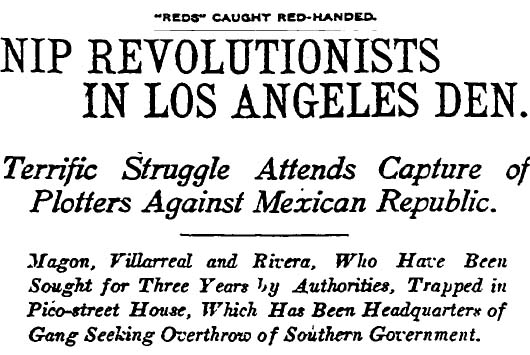
Nov. 9, 1907
Los Angeles

Local sympathizers, anarchists and Socialists are organizing a mass meeting to protest the imprisonment of Ricardo Flores Magon, Librado Rivera, Antonio Villareal and L. Gutierrez De Lara, who are being held on charges of trying to overthrow the Mexican government.
After years of avoiding capture, Magon, Rivera and Villareal were arrested Aug. 23 at 111 E. Pico St. after a brawl with Thomas Furlong of the Furlong Secret Service Bureau of St. Louis, along with Los Angeles Police Detectives Felipe Talamantes, Thomas F. Rico and two deputies. De Lara was arrested by U.S. marshals at 420 W. 4th St. on Sept. 27.

The Times said of the August incident:
Boy Genius
An EBay Mystery Worthy of Holmes
Some Interesting Oil Facts, 1907-style
November 6, 1907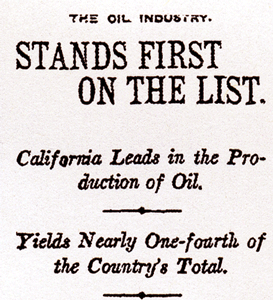
Los Angeles
Oil facts, you say? And you continue to comment, I thought this was a crime blog! Well, the way most people talk about oil companies, you’d think the SS was Toys for Tots. So it’s apropos, especially as we head into Tuesday and face the outcome of Proposition 87.
On this day in 1907, according to the US Geological Survey, the numbers were in: in 1906, California produced 23,098,598 barrels of oil. That’s more than Oklahoma and Kansas combined. (Texas came in with a paltry 12.5 million barrels.) Our oil came primarily from Kern River, Coalinga, Santa Maria, with Los Angeles finishing fourth. The value of California’s 23M barrels came in at 9.5M dollars ($194,973,917 USD 2005). One-sixth of that oil was exported to Japan, Chile, and the American Panama Canal Works.
Today, California is no longer number one (behind Louisiana, Texas and Alaska) but we’re far ahead of those dried-up old fields in Oklahoma and Kansas. In 2007 California should come in with about 274M barrels, over ten times that of 1907. And that, with a value of approximately 16.5B (804M USD 1907). And we’re at our lowest oil production since WWII.

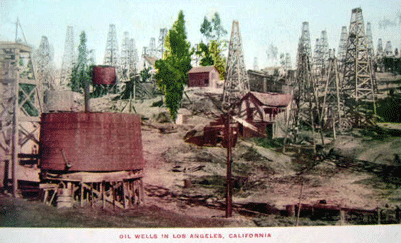
A Many Splendored Thing
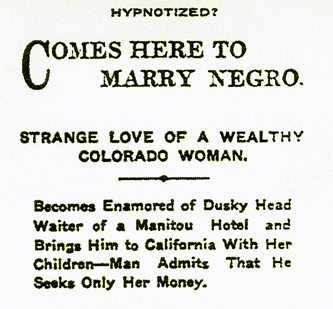
November 6, 1907
Los Angeles
When Mrs. Jenevieve Van Lakum, a well-to-do and refined 35 year-old widow from Manitou, Colorado checked into an apartment at 803 East Fifth Street with her four children and a black gentleman, it was assumed by the proprietor that the gentleman was her porter.
But a certain Patrolman C. H. Jones espied Jenevieve and the black gentleman about town, and made an investigation. It came to light that the man, William Seay, was occupying the same apartment.
Humane Officer Reynolds took the children into custody and the two adults face arrest.
After Mrs. Van Lakum was taken to Central Station and interrogated, she broke down and admitted that she loved the man, and “could not explain her affection for the negro.” They came from the east to Los Angeles with the express purpose of becoming husband and wife, but the LA Powers That Be put the kibosh on that. Police suspected that Seay held some “uncanny” influence over her, but Jeneivieve denied that she had been hypnotized. Seay further stated that he maintained his relations with her only for the money she gave him, which to this point had amounted to about $500 ($10,261 USD 2005).
 Postscript – on November 10, “Humane Officer” Reynolds confessed that the sextet had given him the slip. After having secured Seay’s promise to stay away from the woman, Reynolds allowed Van Lakum to take the children in search of a cottage to rent—and disappeared.
Postscript – on November 10, “Humane Officer” Reynolds confessed that the sextet had given him the slip. After having secured Seay’s promise to stay away from the woman, Reynolds allowed Van Lakum to take the children in search of a cottage to rent—and disappeared.
Says Reynolds: “I believe that she has found a cottage somewhere in the suburbs and is living quietly. Whether the negro visits her or not, I have no positive knowledge, but I am inclined to believe that he does.
“Information from the East states that Mrs. Van Lakum is the member of a prominent family in Chicago. I think that she is irresponsible. I believe she is mentally deranged.”
Let’s hope they found happiness somewhere, though where in 1907 Los Angeles that would be, I do not know. Certainly not in Edendale.
Signs of the Times
November 5, 1907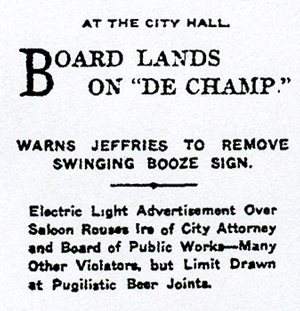
Los Angeles
Just as an innocent toke of reefer leads to a lifetime of laudanum addiction, everybody knows that electric signs lead to…neon!
Neon wouldn’t be introduced to the United States until 1923 (specifically, at the Earl C. Anthony Packard dealership, 10th & Hope Street). That first reefer toke, though…that was the electric sign…
Property owners of 1907 argue that electric signs, particularly those of the swinging variety which jut from the façades of buildings, make the streets look tawdry. Moreover, they nullify the illumination systems on principal business streets, and will become eyesores and nuisances.
The Mayor, however, is outspoken in favor of electric signs. They illuminate business thoroughfares, and are an ornament to the city. A man of vision, our Mayor Harper.
But what to do, then, with the Jim “de champ” Jeffries’ new saloon sign on South Spring? He has had one built and installed, swung over the sidewalk, “bearing in letters as big as one of his mitts the magic pugilistic name.”
While this type of signage violates numerous and sundry City ordinances, the Board of Public Works has ignored similar signs in the downtown area that advertise cafés and theaters, who are crying foul in that municipal authorities have allowed such signs to hang for the last year. Because of Jeffries’ transgression, he and all other sign owners received letters from the City Attorney demanding the removal of any and all projecting signage, the worry being that should these signs become commonplace, “the sidewalks would be converted into tunnels darkened and obstructed by a covering of advertising signs.”
Moreover, a proposed ordinance shall prohibit signage advertising liquor. Can this be?
Mayor Harper stands firm. What will become of our city?
 Here’s a vision of the future: electric signage along Broadway, ca. 1920, as pictured in, uh, this book.
Here’s a vision of the future: electric signage along Broadway, ca. 1920, as pictured in, uh, this book.







